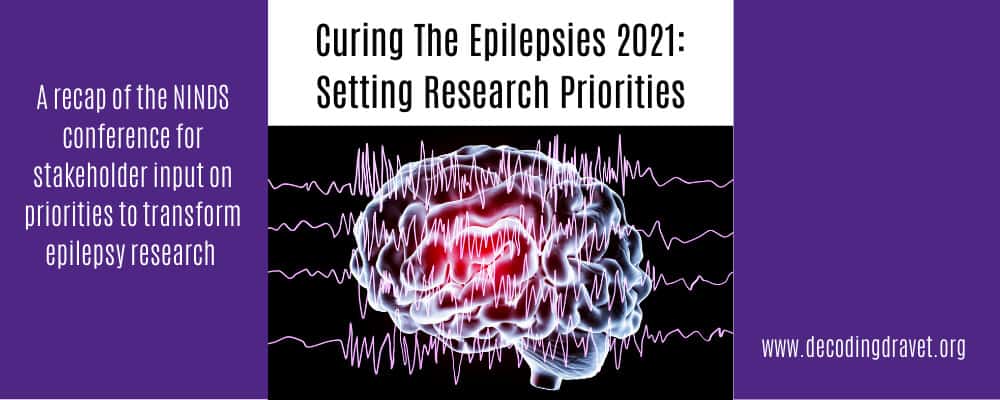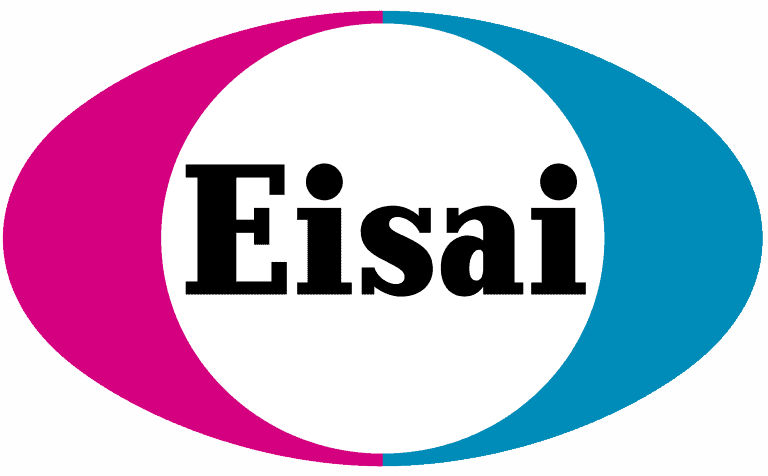On January 5-7, 2021, the NIH/NINDS (National Institute of Health/ National Institute of Neurological Disorders and Stroke) held the“Curing the Epilepsies 2021: Setting Research Priorities” conference in a virtual format. The goal of the conference was to guide updates to the current Epilepsy Research Benchmarks and Transformative Research Priorities with collaborative feedback from all the key stakeholders including expert scientists, clinicians, patients, and patient advocates. The revised benchmarks and priorities will guide the next 5-7 years of epilepsy funding and research.
The sessions began with an introduction session (Walter Krorshetz, MD- Director of the NINDS) and an overview of the Benchmarks (Vicky Whittemore, PhD-NINDS). We reviewed that while the NIH has funded over $150 million in epilepsy research every year since 2014 (the majority through NINDS), the funding is still not commensurate with the disease burden of epilepsy. Dr. Koroshetz underlined the importance of communication and collaboration across all the various stakeholders, a topic that would be revisited time and time again throughout the conference as absolutely vital to making progress. In fact, these collaborative conferences to “Cure the Epilepsies” began in 2000, stemming from recognition that we need to work together to shift from treating the seizure to truly curing the underlying cause. The research benchmarks were developed from this initial meeting and have been minimally revised and expanded following subsequent feedback at meetings in 2007 and 2013 to include the study of comorbidities and Sudden Unexplained Death in EPilespy (SUDEP). The benchmarks have been used to measure what has been accomplished and where the most urgent efforts should be directed. While there is much to be proud of in the progress that has been made in 20 years through the establishment of the benchmarks and the collaborative research environment surrounding them, it was also apparent that it simply has not been enough. Ana Poduri, MD and Eric Marsh MD, PhD finished the initial session by really outlining why we need to be transformative in our approach moving forward. Too many individuals still live with epilepsy (1 in every 26), and again, too many of those patients do not respond to current treatments (1 in every 3). Moreover, despite first, second, and now third line treatments, the patient outcomes have not really improved. There are still major unknowns in our understanding of epilepsy, and we will need collaboration and input from every stakeholder to make significant progress. The audience was challenged to participate in full and open discussion of truly transformative ideas that could propel the field forward.
In the next session the focus moved to targeted treatments for epilepsy. Daniel Lowenstein, MD discussed how far treatments for epilepsy have come throughout human history and yet how much is still lacking. Despite a revolution of pharmaceuticals and treatments, the overall efficacy of newer drugs does not appear to be improved over those we had almost 50 years ago. He reiterated how many cases of epilepsy remain refractory and the substantial side effects of many medications. Finally, he identified key obstacles including limitations of animal models, the complexity of the human brain, the lack of understanding of the interplay between the brain and other body systems, and the need for next generation technological tools to resolve these complexities. The next several speakers (Heather Mefford, MD, PhD and Erin Heinzen, PharmD, Phd) highlighted how far we have come in the last 20 years in our understanding of the genetic causes of the epilepsies, and as such, genetic diagnoses are coming more quickly and genetic treatments are becoming a reality. However, despite these advancements, there are still many patients who go undiagnosed for too long or indefinitely. They called for the development of novel technologies, new approaches to data collection and analysis, and again, more collaboration across researcher groups and scientific disciplines. We next took a look at issues relevant to the final stages of treatment development- clinical trials. Dennis Dlugos, MD, MSCE discussed the complexities of assessing outcome measures beyond the seizure in clinical trials and how we likely need improved measurement tools and longer clinical trials to understand the efficacy of therapeutics on outcomes like cognition and developmental behavior. There was also discussion of the ethical considerations surrounding disease modifying therapies and equitable access to all patients in need (Stanley Crooke, MD Phd- n-lorem Foundation). Ideas flew surrounding large-scale genome sequencing efforts and large-scale patient medical history databases to elucidate some the outlying questions that could perhaps lead to more informed clinical decisions surrounding diagnosis and therapy. Some of the major takeaways following the discussion section of this session were that large collaborations will be necessary to tackle these issues and these collaborations should be supported by streamlined databases to compile and share large amount of experimental and clinical data.
The third session focused on how researchers model the human epilepsies. We heard from a panel of researchers who study epilepsy in a wide range of model systems including patient-derived cell models, drosophila (fruit fly), zebrafish, genetic mouse models, other rodent models, dogs, pigs, and non-human primates. The strengths and weakness of each model were examined and the participants identified major gaps in our ability to model many aspects of epilepsy and particular comorbidities such as behavioral abnormalities. The point was additionally made that often the patients themselves act as the “guinea pigs” trialing medications and therapies, leading patient advocates to be the ones championing the development of animal models (Kim Nye- TESS Foundation). Again, a major theme following the discussions of how to advance model systems for epilepsy was that advancements would happen more quickly if collaborations were facilitated between research groups as part of special initiatives to develop, characterize, and screen animal models. Additionally, collaborations between basic scientists and those running clinical trials may lead to faster translation from bench to bedside. There may need to be reassessments of what the limitations are of each model system and whether we can leverage human records already sitting in medical databases to understand more about epilepsy where models cannot inform. And once more, the participants called for centralized databases to share large amounts of detailed information, as well as facilitation of physical resource sharing of animals, between research groups as a way to greatly increase the pace and progress of epilepsy research.
The fourth session focused on biomarkers for epilepsy and seizures. We heard about the potential types of biomarkers from David Henshall, PhD, to categorically include: 1) molecular, 2) EEG, 3) imaging. Biomarkers could be beneficial for the diagnosis and prevention of seizures, epilepsy, and/or epileptogenesis as well as various comorbid conditions. However, there are a great many considerations when identifying appropriate biomarkers including sensitivity, specificity, timing windows, and practicality of regular use. The discussion sessions led to input that we could be utilizing existing patient health records to identify biomarkers and it is terribly frustrating that so much patient data is sitting there underutilized. To that end, again, there were numerous calls for organized, centralized databases to curate such patient data to be used for research questions. Lastly, an important point was brought up that development of biomarkers need to include considerations for use outside of clinical settings to positively impact day-to-day life for those with epilepsy.
The fifth session focused on how to use big data in epilepsy research, which was a topic that we had already touched on in every previous session as a suggested way to move the field forward. Megan O’Boyle (Phelan McDermid Syndrome Foundation) challenged that while big data collection from patient populations is incredibly important, not having a centralized database is a huge problem. William Stacey, MD, PhD described the major challenges are in sharing the data due to software, hardware, and methodology differences. Dr. Stacey went on to point out that not only do we need to overcome how we can share the data, we also must process the data in meaningful ways, and this may mean we need to form unique cross-discipline research collaborations. Discussions of harnessing existing patient data and novel partnerships with industry were proposed as ways to advance this sector of research.
Session six explored several topics in epilepsy that hold potential for transformative outcomes. Speakers discussed health services and inequity in access (Dave Clarke, MD), novel BRAIN initiative technologies that are revolutionizing our ability to study brain signaling in real time (Ivan Soltesz, Phd), epilepsy occurrence and comorbidity in the elderly (Alice Lam, MD), how the study of epigenetics may have far reaching impacts on our understanding of epilepsy gene regulation (Anne Schaefer, MD, PhD), revolutionizing and harnessing the historically successful metabolic targeting of the ketogenic diet (Manisha Patel, Phd), and investigating the still poorly understood impacts of the microbiome on epilepsy (ToreEid, MD, Phd). The participants shared diverse discussion points surrounding the tremendous potential each of these research avenues might have to impact outcomes in epilepsy. Another common theme re-emerged, that the epilepsy field may need to collaborate with experts in other disciplines to make breakthroughs in these areas.
The final session really focused on recapping key take-aways from the previous sessions. Brandy Fureman, PhD (Epilepsy Foundation) led us through rallying cries put forth by the inspiring personal and patient advocacy stories that were shared throughout the conference. Dr. Fureman began by sharing an essential advocate mantra: “Nothing about us, without us.” She referenced how Ilene Penn Miller (Rare Epilepsy Network) pointed out that an entire lifetime from birth to adulthood has gone by since the first curing epilepsy conference in 2000. In her talk, Ilene passionately emphasized that \”if we go diagnosis by diagnosis, it will take hundreds of years to find cures for everyone and the paradigm must shift now.\” Dr. Fureman also recounted how Amber Freed (SLC6A1 Connect) challenged us all to “fight like a mother” after she shared her own frustrating journey to a diagnosis and search for therapeutic options for her son. Dr. Fureman referenced the advocacy efforts of Kim Nye (TESS Foundation) who asked “Do my children’s lives depend on a mouse, and do I, their mother, have to make that mouse?”. While Kim’s efforts to develop a mouse model are an applaudable achievement, it is unfair and unsustainable for advocates and families to shoulder the responsibility for spurring experimental model development. Dr. Fureman summarized an urgent call from Steve Roberds, PhD for transformative research for families whose daily lives are greatly impacted by epilepsy. Next, Dr. Fureman reminded us of Megan O’Boyle’s discussion of the non-centralized and varied repositories for patient data that make her question if her daughter’s samples and data will ever be used to make a difference. When Dr. Fureman came to Gabi Conecker’s (Wishes for Elliott) talk, she brought our attention to her rousing ending call for \”COVID-level urgency that includes a national strategy, integrated data, and increased collaborations.\” Dr. Fureman then reminded us of the moving personal story Laura Lubbers, PhD (CURE Epilepsy) shared of her own family’s journey with epilepsy that emphasized “wait and hope is no strategy” and called out that the “silos of epilepsy research and care are failing our loved ones.” Finally, Dr. Fureman concluded that these stories exemplified that the current system is failing to translate exciting basic scientific discoveries into meaningful outcomes for patients and families living with epilepsy.
Upon conclusion of the final discussion, it seemed clear that the path forward was not to continue the status quo, but to encourage radical changes to the processes we currently use to facilitate scientific discovery. The themes of the meeting seemed to be big collaboration and big sharing of data in efforts much larger and more diverse than have been previously tried. The next steps will be for NINDS to continue to update the benchmarks and priorities based upon the additional input gathered at this meeting. Hopefully, these will lead to new avenues of funding to encourage ideas along the lines of these emerging themes of collaboration and sharing. While there is apparently great willingness among the stakeholders to participate in these opportunities, there are challenges to bucking the norms beyond the lack of funding mechanisms. It will be of critical importance to keep the patient voice ever present in these conversations so we all remain focused on the end goal of improved outcomes for patients and families who are still awaiting cures for epilepsy.
The presentations from this conference were recorded (Day 1, Day 2, and Day 3) and can be found at the NIH VideoCast website.






